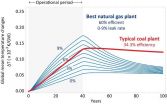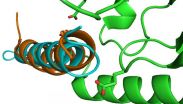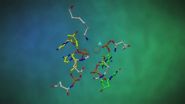(Press-News.org) The same research team that developed the first laser based on a living cell has shown that use of fluorescent proteins in a solid form rather than in solution greatly increases the intensity of light produced, an accomplishment that takes advantage of natural protein structures surrounding the light-emitting portions of the protein molecules. The findings from investigators Seok Hyun Yun, PhD, of the Wellman Center for Photomedicine at Massachusetts General Hospital and Malte Gather, PhD, of the University of St. Andrews in the U.K. appear in the online journal Nature Communications.
"We found that the size and shape of fluorescent proteins are such that their brightness is at the maximum when they are in their most concentrated form," says Yun. "It is almost as if, through millions of years of biological evolution, Nature optimized these proteins for maximal brightness. Now we have harnessed this property to develop several miniature solid-state lasers."
"Beyond directly using biologically produced fluorescent proteins, studying how they manage to generate light so efficiently at high concentration can guide the design of future, more efficient synthetic materials," adds Gather.
In a 2011 paper published in Nature Photonics, Yun and Gather described using a single cell genetically engineered to express green fluorescent protein (GFP) to amplify the light particles called photons into brief pulses of laser light. Within living cells, fluorescent protein molecules are surrounded by water molecules and other proteins, so their concentration is limited. The current study was designed to investigate the development of a laser based on fluorescent proteins in a solid state, which would be easier to incorporate into other devices.
The portion of a fluorescent protein molecule that actually emits light - called a fluorophore - is enclosed in a cylindrical protein structure that keeps the fluorophores of adjacent molecules from getting too close to each other, which would reduce the amount of light lost to a phenomenon called quenching. To investigate their hypothesis that these structural features prevent quenching in naturally occurring fluorescent proteins, even at the highest concentrations, the researchers measured the intensity of light emitted by GFP solutions of varying concentrations and by a thin film of dried GFP, and comparing those results with the light produced by an artificial fluorescent dye.
While at lower concentrations increasing the levels of both GFP and the dye produced increasing fluorescence, at a certain point the amount of light emitted by the artificial dye began to drop off until no light was detectable from the solid form of the dye. In contrast, the fluorescence of GFP continued to intensify with higher concentrations and maximum brightness was achieved by the solid form, supporting the theory that the fluorophores of GFP and other natural proteins are protected against quenching.
With this evidence that a solid form of GFP produces the brightest light, the investigators first constructed a laser device in which a thin film of dried GFP is sandwiched between two highly reflective mirrors. Compared with devices utilizing lower concentrations of GFP in solution, the solid-state GFP laser required 10 times less excitation energy to start lasing.
Another device took advantage of the "coffee-stain effect," in which material dissolved in solution is deposited in a ring around the edge of a drop as it dries. The team's experiments revealed that the light emitted by the protein molecules within microscopic rings formed by dried droplets of a fluorescent protein is amplified as it circulates around the ring, leading to production of laser light. Putting rings of different types of fluorescent proteins close together enabled the investigators to realize multi-color laser emission. Changes in the humidity of the environment of the protein rings changes the intensity of light emitted, indicating that devices based on the effect could be used as sensors.
"This GFP ring laser is the first laser made entirely of proteins," says Yun. "In the future biocompatible lasers may be implanted in the body or embedded inside tissues to enable optical sensing of the molecular and physical environment, stimulation of cells or activation of light-sensitive drugs."
INFORMATION:
Yun is an associate professor of Dermatology at Harvard Medical School, and Gather is a professor at the University of St. Andrews School of Physics and Astronomy. Support for the study includes National Science Foundation grant ECCS-1101947, National Institutes of Health grants P41EB015903 and R21EB013761; Department of Defense grant FA9550-11-1-033 and Korea National Research Foundation grant R31-2008-000-10071-0.
Massachusetts General Hospital, founded in 1811, is the original and largest teaching hospital of Harvard Medical School. The MGH conducts the largest hospital-based research program in the United States, with an annual research budget of more than $785 million and major research centers in HIV/AIDS, cardiovascular research, cancer, computational and integrative biology, cutaneous biology, human genetics, medical imaging, neurodegenerative disorders, regenerative medicine, reproductive biology, systems biology, transplantation biology and photomedicine.
CHARLOTTESVILLE, Va. -- The majority of streams in the Chesapeake Bay region are warming, and that increase appears to be driven largely by rising air temperatures. These findings are based on new U.S. Geological Survey research published in the journal Climatic Change.
Researchers found an overall warming trend in air temperature of 0.023 C (0.041 F) per year, and in water temperature of 0.028 C (0.050 F) per year over 51 years. This means that air temperature has risen 1.1 C (1.98 F), and water temperature has risen 1.4 C (2.52 F) between 1960 and 2010 in the Chesapeake ...
You don't have to be a jerk to come up with fresh and original ideas, but sometimes being disagreeable is just what's needed to sell your brainchild successfully to others. However, difficult or irritating people should be aware of the social context in which they are presenting their ideas. A pushy strategy will not always be equally successful, warn Samuel Hunter of Pennsylvania State University and Lily Cushenbery of Stony Brook University in the US, in an article in Springer's Journal of Business and Psychology.
People are often labelled as jerks if they are disagreeable ...
Washington, D.C.-- Natural gas power plants produce substantial amounts of gases that lead to global warming. Replacing old coal-fired power plants with new natural gas plants could cause climate damage to increase over the next decades, unless their methane leakage rates are very low and the new power plants are very efficient.
These are the principal findings of new research from Carnegie's Ken Caldeira and Xiaochun Zhang, and Nathan Myhrvold of Intellectual Ventures that compares the temperature increases caused by different kinds of coal and natural gas power plants. ...
Washington, DC (December 8, 2014) - Scrolling through the comments section on a news site is like seeing a verbal war before your eyes. Internet trolls flourish in an anonymous world, so much so that sites like Reuters and Popular Science have done away with the comment sections altogether. But there has to be a better way to let the audience engage in a civil manner. A recent study published in the Journal of Computer-Mediated Communication by researchers at the University of Texas, Purdue University, and University of Wyoming, found that having a journalist engage with ...
A technique that can identify causes of cancer invisible to genetic sequencing has uncovered large sets of previously unknown pancreatic cancer genes. It is hoped that this study will boost research into a disease that is still poorly understood and for which five-year survival rates have stood at around 5 per cent for the past four decades.
The technique works by introducing sections of DNA called piggyBac transposons into the mouse genome. Transposons jump around within the genome, reinserting themselves at random and causing a different mutation in each cell of the ...
ITHACA, N.Y. - There is cloud hanging over climate science, but one Cornell University expert on communication and environmental issues says he knows how to help clear the air.
In the December issue of Nature Climate Change, Jonathon Schuldt, assistant professor of communication, argues that only by creating a "science of climate diversity" can climate science and the larger climate change movement overcome a crippling lack of ethnic and racial diversity.
"There is an invisible, but very real barrier to climate engagement," Schuldt said. "We need to engage with all ...
A genetic misfire called the 3q26.2 amplicon can cause real havoc. In fact, it is among the most frequent chromosomal aberrations seen in many cancers, including ovarian and breast cancers.
Researchers behind a study at The University of Texas MD Anderson Cancer Center believe they may have found a molecule-based approach to halting 3q26.2's destructive nature. By manipulating a non-coding microRNA (miRNA) known as miR569 that is part of the amplicon, scientists were able to increase cell death in vitro and in vivo. MicroRNAs are short, non-coding RNA molecules that are ...
Alexandria, Va. -- Methane is often found naturally leaking from the seafloor, particularly in petroleum basins like the Gulf of Mexico or along tectonically active continental margins like the U.S. West Coast, but such plumes were not expected along passive margins, like the East Coast of North America. Now, however, the discovery of hundreds of methane seeps on the seafloor along the U.S. East Coast suggests that such reservoirs may be more common along passive margins than previously thought. The release of such methane globally may have a significant influence on climate, ...
BLOOMINGTON, Ind. -- A new treatment for adult-onset diabetes and obesity developed by researchers at Indiana University and the German Research Center for Environmental Health has essentially cured lab animals of obesity, diabetes and associated lipid abnormalities through improved glucose sensitivity, reduced appetite and enhanced calorie burning.
In preclinical trials, the new peptide -- a molecular integration of three gastrointestinal hormones -- lowered blood sugar levels and reduced body fat beyond all existing drugs, according to the work co-led by IU Distinguished ...
Scientists from the Spanish National Cancer Research Centre (CNIO), led by Guillermo Montoya, have developed a method for producing biological crystals that has allowed scientists to observe --for the first time-- DNA double chain breaks. They have also developed a computer simulation that makes this process, which lasts in the order of millionths of a second, visible to the human eye. The study is published today by the journal Nature Structural & Molecular Biology.
"We knew that enzymes, or proteins, endonucleases, are responsible for these double strand breaks, but ...





